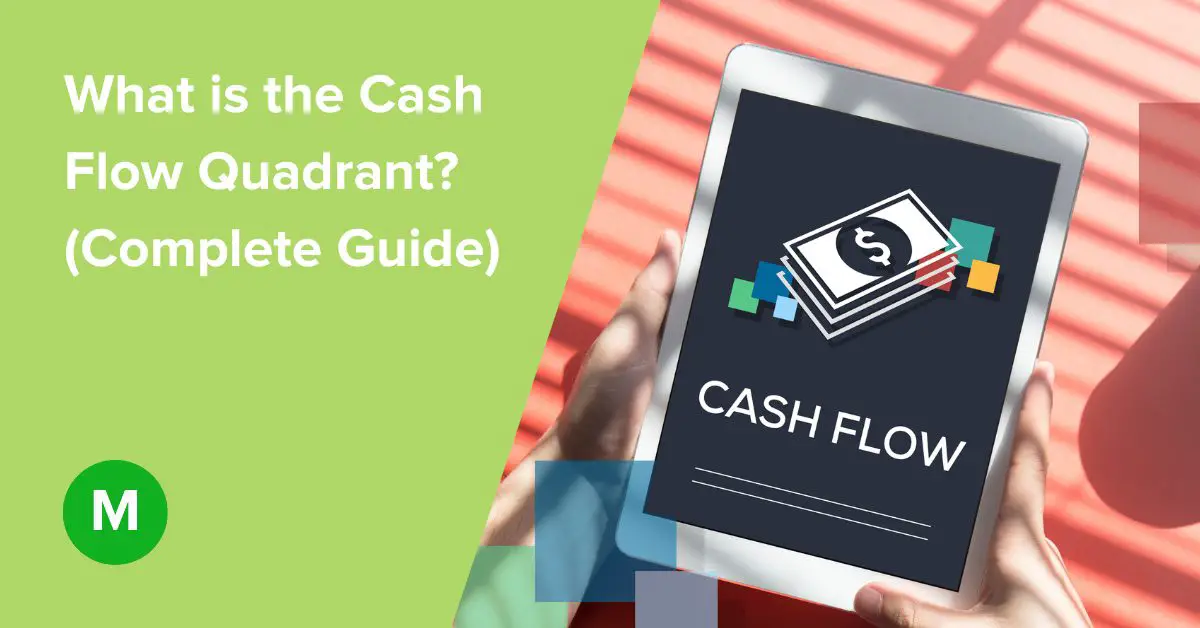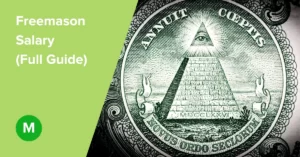What is the Cash Flow Quadrant? (Complete Guide)
If you’re a fan of Robert Kiyosaki’s rich dad series book, then you’ve heard of the book: The cashflow quadrant: Rich Dad’s Guide To Financial Freedom.
It’s another classical read that completely changes how you think about money. It makes you see the financial world from an entirely different perspective.
What we learned in school was to work hard, get good grades, and then land a high-paying secure job with excellent benefits till retirement. But the rich dad books challenge this perception by educating us on different ways of making money that leads to financial freedom.
This article highlights a major concept discussed in one of Robert’s books, the cash flow quadrant.
- What is cash flow according to Rich Dad Poor Dad?
- What are the 4 cash flow quadrants?
- The difference between the left side of the cashflow quadrant and the right side of the cashflow quadrant
- What it means to be really rich
- Changing quadrants: moving from the E-S quadrant to the B-I quadrant
- Which side of the cash flow quadrant is best for you?
- Final Takeaways: Some tips to take home from rich dad’s cashflow quadrant
- FAQs about the cashflow quadrant
What is cash flow according to Rich Dad Poor Dad?
In simple terms, cash flow refers to the money flowing into and out of your business. It can be positive or negative depending on the performance of your business.
You can also have your own cash flow in your personal finance. That is, money that enters your pocket and that which goes out of your pocket. If there’s more money entering your pocket, then that’s a positive cash flow. If more money goes out of your pocket, then that’s a negative cash flow.
What are the 4 cash flow quadrants?
According to Robert Kiyosaki’s book, the cash flow quadrant, wealth comes from four different sources. The diagram below illustrates the financial model of how money and wealth come from these four different sources.
The cashflow quadrant
The Employee (E)
Employees are people who have jobs or are working for someone to earn income in the form of salaries. Most middle-class earners are in this quadrant.
Usually, they have only one source of income, which is their salary. Some may have two or three jobs to make some extra cash.
For employees, a permanent job provides more security than owning a business or investing. To them, being the latter is risky especially if you have bills to pay and a family to take care of.
If they need more money, employees build on their skills or upgrade their education to climb the corporate ladder and earn higher salaries and get steady jobs packaged with benefits.
The Self-Employed (S)
Consultants, accountants, lawyers, doctors, engineers, and all manner of specialists fall in this category. People who own small businesses are also placed in this quadrant.
The self-employed are best known to be perfectionists. They rarely delegate their duties and prefer to do everything on their own. This means that money only streams in when they’re working. If they take a one-year vacation, so does their source of income.
Individuals operating in this quadrant are more risk-tolerant and also don’t like the idea of working for someone else. They can start businesses and be successful but at the cost of their time.
The Business owner (B)
Business owners, as their name suggests, own businesses with established systems that earn them money even when they’re not involved in the business.
They usually hire specialists (i.e. those in the S quadrant) and people smarter and more skilled than they are to help run their business.
A business owner can take a one-year vacation from their business without working and return to find the business making more profits than they left it. This is because it’s not them who are working but the system they established which is bringing them money.
Society perceives that business owners are the highest risk takers. However, from the perspective of a business owner, being an employee is riskier as they are one paycheck away from losing their source of income. They have no control over their time and money and they’re more subject to bad debt compared to business owners.
Moreover, during an economic crisis, business owners can control their cash flow more than employees and self-employed individuals. If they want more money, they create a new product or establish another system that will increase their income.
The Investor (I)
Investors are the ultimate financial experts. They possess the highest level of financial education and are highly skilled in the financial world.
Their wealth comes from acquiring assets that make them steady passive income in the form of cash flows. They acquire these assets using other people’s money (OPM) and other people’s time (OPT) without working for the money. Usually, they invest their money into businesses and systems which multiply their wealth.
The richest people in the world are investors. Over 70% of their income is generated from acquired assets and the remaining 30% may come from wages. They also enjoy more tax breaks compared to employees and small business owners.
Most investors don’t work at all. If they desire to make more money, they look for opportunities to invest to make more passive income.
The difference between the left side of the cashflow quadrant and the right side of the cashflow quadrant
How you receive your income determines the quadrant from which you operate. For example, if you get earned income, then it means you operate from the left side. Meaning you’re either an employee or a self-employed individual. Those operating from the right side earn passive income from businesses and investments.
There are many differences between those who are on the left side of the cash flow quadrant and those on the right side of the cash flow quadrant.
A distinct difference between the two sides of the quadrant is the time and financial freedom each possesses. Employees and the self-employed trade their time and freedom to get money to cater to their needs. Business owners and investors, on the other hand, use other people’s time and money to gain more control over their time and achieve financial freedom.
What it means to be really rich
Most people think that being rich means having a lot of money, a flashy car, a mansion, vintage furniture, and wearing expensive clothes and shoes from Louis Vuitton. Yes, the middle class can afford an expensive lifestyle, but most of them go for it at the cost of bad debt.
How rich you are is determined by how much money you keep. For employees and the self-employed, their income first gets taxed by the government before it enters their pockets. Whatever remains after taking care of their expenses is usually too little to furnish the lifestyle they desire. This makes them go into debt which drives them into the dreaded rat race trap.
The rich, such as business owners and investors, keep most of their money as they get frequent tax breaks and pay the least taxes. The more they invest their money into businesses and other investments, the more they increase their wealth and keep their money. A lavish lifestyle is only a reward for the money they invested that worked for them to bring more money.
Changing quadrants: moving from the E-S quadrant to the B-I quadrant
Do the following statements run in your mind every time you go to your 9-5 job?
- I’m tired of living paycheck to paycheck
- I hate my job
- I wish I had more time to spend with my friends and family, or doing other hobbies
- I want more freedom
If they do, then you might want to consider changing quadrants and start pursuing financial freedom.
The good news is, that it’s possible to change your quadrant. However, you’ll need a change of mindset. From thinking about job security and high salaries to financial security and increasing cash flows. You need to embrace taking risks, accepting failure as part of your success journey, and a lifetime of learning.
“Anyone who stops learning is old, whether at twenty or eighty. Anyone who keeps learning stays young.”
~Henry Ford
Dealing with your mindset while shifting quadrants
You may be dying to quit that job and start your own business and hope that someday it will be successful enough to make you retire early. That means you long to shift to the right side of the cash flow quadrant.
However, shifting to the right side of the quadrant means you need to change how you think about money. You need to stop working for money and let the money work for you.
Traditional education in school teaches students to work hard, get good grades, and then land a well-paying secure job with great benefits. This is what most people are wired to do which creates this massive influx of employees who can only work to achieve another person’s dream in exchange for money. This is at the cost of their time and energy. It’s not bad to be an employee, but what school fails to teach is that not all people can be employees.
In fact, you’ll realize that most people don’t like their jobs, and they long to quit so they can have more time and freedom. Sadly, employment doesn’t offer these timeless benefits most of the time.
Addressing your fears when changing quadrants
A lot of people fear changing quadrants. They hate their jobs and want to have more time and freedom but they fear making that first step.
You’ll always hear them saying, “I have a family, I cannot risk leaving my job now”, “starting a business is risky” “investing is risky”, and so forth. It’s normal to feel anxious about your financial obligations. But you don’t need to add more frustrations to your obligations by living paycheck to paycheck and living your retirement years a bitter person.
You can start your journey to financial freedom by taking small baby steps. First, invest in your financial education. Read books, attend seminars, get a mentor who’s successful in the business industry, fail, get up and learn from your mistakes. The secret is to not give up.
Starting a business or becoming an investor is not easy, but with a strong will to succeed, you will make it.
The cost of staying in the E-S quadrant
Staying in the E-S quadrant means you’ll sacrifice your time and freedom to achieve another person’s dream.
It also means you’ll have to bear more taxes and sometimes live paycheck to paycheck to keep up with the lifestyle you desire. People in the E-S quadrant also tend to take bad debt which usually gets them stuck in the rat race.
The mentality of having a secure job is what keeps people in the E-S quadrant stuck in situations they don’t want to be in. While employment gives you job security till retirement, being a business owner or investor will give you what everyone dreams of – financial freedom.
Which side of the cash flow quadrant is best for you?
At times, based on your personality, one side of the cash flow quadrant favours you more than the other. You’ll find that working on a particular quadrant comes easier and naturally to you than the other. For example, people who tend to be perfectionists thrive as self-employed individuals.
However, if you truly want to build infinite wealth that can literally last for generations, it’s best to become an investor. It’s the quadrant with the highest risks but with the best benefits that every individual dreams of. Plenty of time, freedom, and money to do as you please and travel wherever you’d like.
Final Takeaways: Some tips to take home from rich dad’s cashflow quadrant
True financial freedom is defined by the path you take in the four categories of the cash flow quadrant. The path you choose will determine how infinite your wealth will be in the future and how fast you’ll achieve financial freedom.
Money is only an idea, a tool that can help you achieve what you want in life. Freedom may be free, but it comes at a price. Wealth is not defined by how much money you make, but by how much you keep and how long it works for you.
It’s not easy for employees and self-employed to achieve financial freedom. Business owners and especially investors, make a lot of money that compounds with time making them financially free for a long period of time.
FAQs about the cashflow quadrant
Is being an E-S riskier than being a B-I?
This narrows down to the mindset of the individual operating from either side of the cash flow quadrant.
For employees, having a safe secure job with great benefits is better than running a business or investing your money. To them, the latter is riskier while the former provides more security.
Business owners and investors on the other hand view employment as risky because being an employee means you’re one paycheck away from losing your income.
Which cash flow quadrant are you likely to pay the highest tax rate?
The employees and self-employed pay higher taxes compared to business owners and investors.
The government gives tax breaks to business owners and investors to encourage them to build businesses and investments that create more employment opportunities for its citizens. More employment opportunities mean more taxes to the government.







